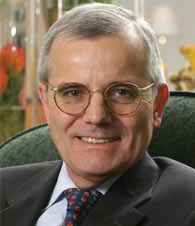|
Executive Interviews: Interview with Dr. Bolko V Oetinger on Business Model Innovation
April 2009
-
By Dr. Nagendra V Chowdary
Firstly, a word about BCG’s
illustrious strategy legacy. BCG, from
the days of Bruce Henderson, had
been synonymous with high-end
strategy making with its powerful
tools becoming standard strategy
lexicon. How do you reflect on that
legacy?Do you think it lost some of its
sheen when compared with its
heydays of 1970s and 1980s?
Not at all! one should not confuse
tools with strategic thinking. The
tools have become standard textbook
knowledge. The hallmark of strategy
are not tools, the hallmark is critical
thinking and that, by nature, should
never come to an end. If it does you
have given up your responsibility as
an entrepreneur or as a manager. BCG
has continued to develop ideas,
processes, approaches and even
modalities of strategic thought. I hope
we will get a chance to discuss them
further.
-
What is the mandate for Strategy
Institute at BCG? What does it focus
on?
The Strategy Institutemission is to get
ahead of key developments which
influence business and society and to
enrich BCG’s strategic thinking by
transferring strategy insights from
other fields to business. So, it
emphasizes ‘transfer’ innovation.
When I founded the Institute in 1998
itwas clear in mymind that business,
academics and even consultants had
trivialized the field of strategy into a
simple toolbox of “how to…” tools. I
wanted to give back to strategy its
richness, breadth and endless
creativity which drive business at its
best. By the way, this is the reason
why we always discover new
business models. You do not find a
new business model with a new tool.
Please do not misunderstand me. I
am not against tools. Tools are terrific
for stable business situations. You
will always use the existing tools and new tools to improve your existing
business model. However, the mind
that discovers new business models
needs different stimuli. -
And now spatial thinking. What is
the relationship between spatial
thinking and strategy? What has
contributed to this new way of
looking at strategy? Let me answer this using a backward
logic: Once a new business model
emerges, take as an example the iPod
with iTunes, you realize that the
existing business model (music sold
via CDs) is only one particular formof
distributing music. Over decades the
industry somehow assumed that is
the only one. However, CDs occupy
only one particular area in the larger
space of music distribution. The
space is designed by various variables
like content, mobility, convenience,
choice, communication technology,
web technology, artists, etc. It might
be a 10 dimensional space which
might be empty for 99%. But
somewhere might be (not must be) a
combination of variables that can be
financially exploited. Spatial thinking
makes you aware that all our existing
business models are small areas of
land in a vaster space of broader
options. So, there are potentially a lot
of new business models waiting for
entrepreneurs, also in the music
industry: Think about how Madonna
makes money. In one of your very interesting and
concise pieces—Center and
Periphery—you have observed that
center and periphery are not
theoretical concepts and they are true
sources of strategic action. Can you
elaborate on ‘center and periphery’
perspective highlighting the strategy
connotations? By the way, I like to point out “center
and periphery” is a spatial concept.
The distance (again a spatial
connotation!) between the two
visualizes their difference. If you
watch incumbents in mature markets
you observe again and again that
dangerous assaults are not coming
from their direct competitors, their
“colleagues”, but from unknown
companies with different business
models and sometimes even from
outside the “industry we are in”.
Apple was far away even from the
periphery of the CD business,
Ryanair started as a strange airline far
away from the mighty “hub and
spoke” flag carriers like Air France or
Lufthansa. Toyota was completely
underestimated by any of its US
competitors, as are Chinese cars
today in Europe and the US for the
same reasons, lack of quality. In
history you have similar phenomena:
Rome got raided by Germanic tribes
from the North, September 11 was a
cruel attack from the periphery into
the center of the Western financial
world. Even the buildings were
chosen as targets in the center. We
usually underestimate these far
distant attackers, claiming that we
should not confuse apples with
oranges. The apple/orange quote is
the worst service we do to our
strategies. Very successful attackers
from the periphery enjoy our
misunderstanding. They even do not
need to hide behind bushes. The
incumbents’ mind will ignore them
anyway. As business people we
mostly underestimate how fast an
apple becomes an orange. Strategy
requires regular visits of the center at
its periphery! The border is a very
fertile ground of strategic insights.
|
